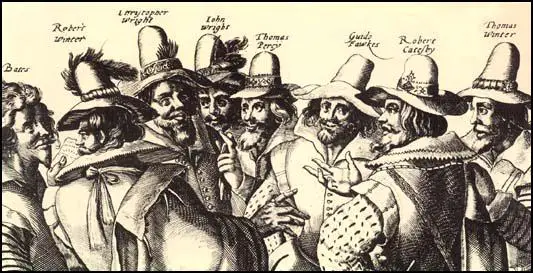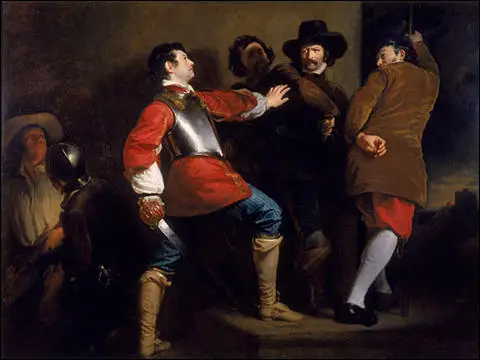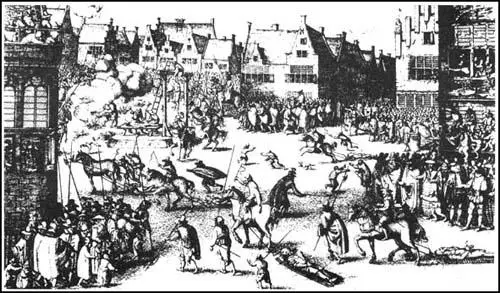Guy Fawkes
Guy Fawkes, the only son of a Edward Fawkes and his wife, Edith Jackson, was born in York in 1570.
Fawkes father was a proctor of the ecclesiastical courts and advocate of the consistory court of the Archbishop of York, and a staunch Protestant. (1)
His mother's family were recusant Catholics, and his cousin, Richard Cowling, became a Jesuit priest. (2)
Edward Fawkes died in January, 1579, and three years later his widow married Denis Bainbridge of Scotton, a Roman Catholic.
Fawkes was educated at St Peter's School in York. Also at the school was John Wright and Christopher Wright. The headmaster, John Pulleyn, came from a family of noted Yorkshire recusants. It is claimed that the three boys were greatly influenced by being taught about the way Henry VIII had persecuted religious dissents. (3)
Guy Fawkes in Spain
In 1592 Guy Fawkes married Maria Pulleyn. He sold the small estate in Clifton which he had inherited from his father and went to fight for the armies of Catholic Spain in the Low Countries. He was described as conscientious and brave and behaved gallantly at the siege of Calais in 1596. A close friend described him as being a devout Catholic who was "pleasant of approach and cheerful of manner, opposed to quarrels and strife… loyal to his friends, but... a man highly skilled in matters of war". (4) Later he travelled to Spain in an attempt to persuade the king to send Catholic troops to invade England. (5)
King James and Roman Catholics
Queen Elizabeth died on 24th March, 1603. Later that day, Robert Cecil, read out the proclamation announcing James VI of Scotland as the next king of England. The following day the new king wrote from Edinburgh informally confirming all the privy council in their positions, adding in his own hand to Cecil, "How happy I think myself by the conquest of so wise a councillor I reserve it to be expressed out of my own mouth unto you". (6)
James left for England on 26th March 1603. When he arrived at York his first act was to write to the English Privy Council for money as he was deeply in debt. His demands were agreed as they were anxious to develop a good relationship with their king who looked like a promising new leader. "James's quick brain, his aptitude for business, his willingness to take decisions, right or wrong, were welcome enough after Elizabeth's tedious procrastination over trifles. They were charmed, too, by his informal bonhomie." (7)
Soon after arriving in London, King James told Henry Howard, 1st Earl of Northampton, "as for the catholics, I will neither persecute any that will be quiet and give but an outward obedience to the law, neither will I spare to advance any of them that will by good service worthily deserve it." James kept his promise and the catholics enjoyed a degree of tolerance that they had not known for a long time. Catholics now became more open about their religious beliefs and this resulted in accusations that James was not a committed Protestant. (8) The king responded by ordering in February 1605, the reintroduction of the penal laws against the catholics. It has been estimated that 5,560 people were convicted of rucusancy during this period. (9)
The Gunpowder Plot
Roman Catholics felt bitter by what they saw as the king's betrayal. They now realised that they were an isolated minority in a hostile community. In February 1604, Robert Catesby devised the Gunpowder Plot, a scheme to kill King James and as many Members of Parliament as possible. Catesby recruited Thomas Wintour and in April 1604, he introduced him to Guy Fawkes. (10)
At a meeting at the Duck and Drake Inn on 20th May, Catesby explained his plan to Guy Fawkes, Thomas Wintour, Thomas Percy and John Wright. All the men agreed under oath to join the conspiracy. Over the next few months Francis Tresham, Everard Digby, Robert Wintour, Thomas Bates and Christopher Wright also agreed to take part in the overthrow of the king. (11)

Catesby's plan involved blowing up the Houses of Parliament on 5th November, 1605. This date was chosen because the king was due to open Parliament on that day. At first the group tried to tunnel under Parliament. This plan changed when Thomas Percy was able to hire a cellar under the House of Lords. The plotters then filled the cellar with barrels of gunpowder. The conspirators also hoped to kidnap the king's daughter, Elizabeth. In time, Catesby was going to arrange Elizabeth's marriage to a Catholic nobleman. (12)
One of the people involved in the plot was Francis Tresham. He was worried that the explosion would kill his friend and brother-in-law, Lord Monteagle. On 26th October, Tresham sent Lord Monteagle a letter warning him not to attend Parliament on 5th November. Monteagle became suspicious and passed the letter to Robert Cecil. Cecil quickly organised a thorough search of the Houses of Parliament. (13)
While searching the cellars below the House of Lords, Sir Thomas Knyvett, keeper of the Palace of Westminster, and his men found Guy Fawkes, who claimed he was John Johnson, the servant of Thomas Percy. He was arrested, and when his men hauled away the faggots and brushwood, they uncovered thirty-six barrels - nearly a ton - of gunpowder. (14)

Guy Fawkes was tortured and admitted that he was part of a plot to "blow the Scotsman (James) back to Scotland". On the 7th November, after enduring further tortures, Fawkes gave the names of his fellow conspirators. "Catesby suggested... making a mine under the upper house of Parliament... because religion had been unjustly suppressed there... twenty barrels of gunpowder were moved to the cellar... It was agreed to seize Lady Elizabeth, the king's eldest daughter... and to proclaim her Queen". (15)
The trial began on the 27th January, 1606. The Attorney-General Sir Edward Coke made a long speech, that included a denial that the King had ever made any promises to the Catholics. He then read out the confessions of the men accused of the crime. Thomas Wintour made a statement where he admitted his involvement but pleaded that his brother, Robert Wintour, should be spared. Everard Digby pleaded guilty, but justified his actions by claiming that the insisting that the King had reneged upon promises of toleration for Catholics. (16)
On 30th January, Everard Digby, Robert Wintour, John Grant, and Thomas Bates, were tied to hurdles and dragged through the crowded streets of London to St Paul's Churchyard. Digby, the first to mount the scaffold, asked the spectators for forgiveness, and refused the attentions of a Protestant clergyman. He was stripped of his clothing, and wearing only a shirt, climbed the ladder to place his head through the noose. He was quickly cut down, and while still fully conscious was castrated, disembowelled, and then quartered, along with the three other prisoners. (17)
The following day, Thomas Wintour, Ambrose Rookwood, Robert Keyes, and Guy Fawkes were taken to the Old Palace Yard at Westminster to be hanged from the gallows, then drawn and quartered in public. A contemporary described Fawkes on the gallows: "Last of all came the great devil of all, Guy Fawkes, who should have put fire to the powder. His body being weak with the torture and sickness he was scarce able to go up the ladder, yet with much ado, by the help of the hangman, went high enough to break his neck by the fall." (18)
According to Camilla Turner he did not die in the way that was expected: "As he awaited his grisly punishment on the gallows, Fawkes leapt to his death - to avoid the horrors of having his testicles cut off, his stomach opened and his guts spilled out before his eyes. He died from a broken neck." His body was subsequently quartered, and his remains were sent to "the four corners of the kingdom" as a warning to others. (19)

This is the traditional story of the Gunpowder Plot. However, in recent years some historians have begun to question this version of events. Some have argued that the plot was really devised by Sir Robert Cecil. This version claims that Cecil blackmailed Catesby into organising the plot. It is argued hat Cecil's aim was to make people in England hate Catholics. For example, people were so angry after they found out about the plot, that they agreed to Cecil's plans to pass a series of laws persecuting Catholics. (20)
Cecil's biographer, Pauline Croft, has argued that this is unlikely to have been true: "In the inflamed atmosphere after November 1605, with wild accusations and counter-accusations being traded by religious polemicists, there were allegations that Cecil himself had devised the Gunpowder Plot to elevate his own importance in the eyes of the king, and to facilitate a further attack on the Jesuits. Numerous subsequent efforts to substantiate these conspiracy theories have all failed abysmally." (21)
Robert Cecil definitely took advantage of the situation. Henry Garnett, head of the Jesuit mission in England, was arrested. As Roger Lockyer has pointed out: "The evidence against him was largely circumstantial, but the government was determined to tar all the missionary priests with the brush of sedition in the hope of thereby depriving them of the support of the lay catholic community. A further step in this direction came in 1606, with the drawing up of an oath of allegiance which all catholics were required to take." (22)
The failed Gunpowder Plot united the nation. The anniversary of 5th November became an annual holiday. In the Parliament that followed the conspiracy James obtained a vote of subsidies and other levies amounting to about £450,000. In April, 1606, James managed to persuade Parliament to accept that the newly designed Union Jack flag would be flown on British ships. English ships would continue to fly the St George's cross, whereas Scottish ones would still use the St Andrew flag. (23)
Primary Sources
(1) Guy Fawkes was arrested on the 4 November, 1605. After being tortured in the Tower of London, Guy Fawkes confessed to planning to blow up Parliament on 17th November 1605.
Catesby suggested... making a mine under the upper house of Parliament... because religion had been unjustly suppressed there... twenty barrels of gunpowder were moved to the cellar... It was agreed to seize Lady Elizabeth, the king's eldest daughter... and to proclaim her Queen.
(2) Philip Sidney, A History of the Gunpowder Plot (1905)
Guy Fawkes refused to name his friends... he was speedily put to torture... he was compelled to confess... The conspirators met their fate with courage, considering the terrible nature of their punishment. Tied to separate hurdles, they were dragged, lying bound on their backs, through the muddy streets to the place of execution, there to be first hanged, cut down alive, drawn, and then quartered.
(3) Robert Crampton, The Gunpowder Plot (1990)
If Guy Fawkes case came up before the Court of Appeal today, the... judges would surely... acquit him... First, no one has ever seen the attempted tunnel. Builders excavating the area in 1823 found neither a tunnel nor any rubble. Second, the gunpowder. In 1605, the Government had a monopoly on its manufacture... The Government did not display the gunpowder and nobody saw it in the cellars. Third, these cellars were rented by the government to a known Catholic agitator... Fourth, the Tresham letter. Graphologists (handwriting experts) agree that it was not written by Francis Tresham.
(4) The Weekly News (31st January 1606)
Last of all came the great devil of all, Guy Fawkes, alias Johnson, who should have put fire to the powder. His body being weak with the torture and sickness he was scarce able to go up the ladder, yet with much ado, by the help of the hangman, went high enough to break his neck by the fall. He made no speech, but with his crosses and idle ceremonies made his end upon the gallows and the block, to the great joy of all the beholders that the land was ended of so wicked a villainy.
(5) Camilla Turner, The Daily Telegraph (5th November, 2014)
The traditional death for traitors in 17th-century England was to be hanged from the gallows, then drawn and quartered in public. But, despite his role in the Gunpowder Plot - which the perpetrators hoped would kill King James and as many members of parliament as possible - it was not to be Fawkes's fate.
As he awaited his grisly punishment on the gallows, Fawkes leapt to his death - to avoid the horrors of having his testicles cut off, his stomach opened and his guts spilled out before his eyes. He died from a broken neck.
His body was subsequently quartered, and his remains were sent to "the four corners of the kingdom" as a warning to others.
Student Activities
Was Queen Catherine Howard guilty of treason? (Answer Commentary)
Henry VIII (Answer Commentary)
Henry VII: A Wise or Wicked Ruler? (Answer Commentary)
Henry VIII: Catherine of Aragon or Anne Boleyn?
Was Henry VIII's son, Henry FitzRoy, murdered?
Hans Holbein and Henry VIII (Answer Commentary)
The Marriage of Prince Arthur and Catherine of Aragon (Answer Commentary)
Henry VIII and Anne of Cleves (Answer Commentary)
Anne Boleyn - Religious Reformer (Answer Commentary)
Did Anne Boleyn have six fingers on her right hand? A Study in Catholic Propaganda (Answer Commentary)
Why were women hostile to Henry VIII's marriage to Anne Boleyn? (Answer Commentary)
Catherine Parr and Women's Rights (Answer Commentary)
Women, Politics and Henry VIII (Answer Commentary)
Historians and Novelists on Thomas Cromwell (Answer Commentary)
Martin Luther and Thomas Müntzer (Answer Commentary)
Martin Luther and Hitler's Anti-Semitism (Answer Commentary)
Martin Luther and the Reformation (Answer Commentary)
Mary Tudor and Heretics (Answer Commentary)
Joan Bocher - Anabaptist (Answer Commentary)
Anne Askew – Burnt at the Stake (Answer Commentary)
Elizabeth Barton and Henry VIII (Answer Commentary)
Execution of Margaret Cheyney (Answer Commentary)
Robert Aske (Answer Commentary)
Dissolution of the Monasteries (Answer Commentary)
Pilgrimage of Grace (Answer Commentary)
Poverty in Tudor England (Answer Commentary)
Why did Queen Elizabeth not get married? (Answer Commentary)
Francis Walsingham - Codes & Codebreaking (Answer Commentary)
Sir Thomas More: Saint or Sinner? (Answer Commentary)
Hans Holbein's Art and Religious Propaganda (Answer Commentary)
1517 May Day Riots: How do historians know what happened? (Answer Commentary)
